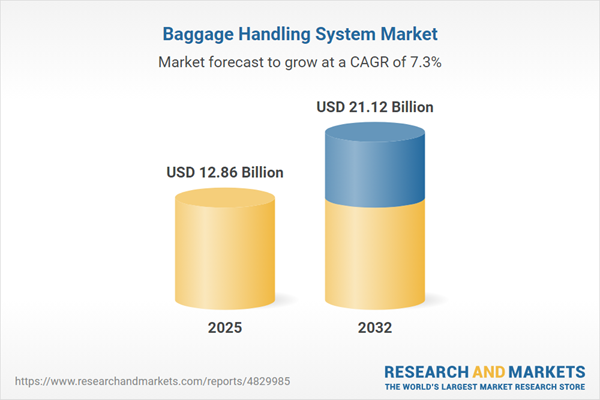Speak directly to the analyst to clarify any post sales queries you may have.
The baggage handling system market is swiftly advancing, driven by the rising need for automation, operational efficiency, and robust security across major transportation hubs. Industry leaders face complex requirements to modernize systems and mitigate evolving risks, making informed investment decisions essential for maintaining competitive advantage.
Market Snapshot: Growth, Demand Drivers, and Forecast for Baggage Handling System Market
The baggage handling system market grew from USD 12.04 billion in 2024 to USD 12.86 billion in 2025. It is projected to continue its trajectory at a CAGR of 7.27%, reaching USD 21.12 billion by 2032. Sustained growth is underpinned by modernization initiatives at airports, logistics providers, and transport networks seeking improved throughput and seamless passenger experiences. Widely adopted digital and security technologies have become essential in response to intensifying demands for speed, accuracy, and regulatory compliance.
Scope & Segmentation
- System Types: Conveyor systems, destination coded vehicles (DCV)
- Technology: 1D and 2D barcodes, active RFID, passive RFID
- Operation Modes: Automated, manual
- Deployment Modes: New installations, retrofit and upgrades
- Functions: Check-in & loading, reclaim & departure
- End Users: Airports, cruise terminals, logistics & transport companies
- Regions: Americas, Europe, Middle East & Africa, Asia-Pacific
- Representative Countries: United States, Canada, Mexico, Brazil, United Kingdom, Germany, France, UAE, China, India, Japan, Australia, and others
- Companies Covered: Alstef Group, Amadeus IT Group SA, Babcock International Group PLC, Beumer Group, Brock Solutions, Daifuku Co., Ltd., Dalmec Inc., Diversified Conveyors International, LLC, Duravant LLC, FIVES Group, G&S Airport Conveyor, KieTek International, Inc., KineMatik SA, Leonardo S.p.A., Logplan, LLC, Mpac Group plc, Omega Aviation, Inc., Pteris Global Limited, SATS Ltd., Sick AG, Siemens AG, SITA N.V., Smiths Detection Group Ltd., Vanderlande Industries B.V., Victory Ground Support Equipment
Key Takeaways
- Automation maturity is rising as airports and logistics hubs increasingly integrate robotics, artificial intelligence, and real-time analytics for enhanced process control.
- Adoption of dynamic routing algorithms and predictive maintenance solutions is reducing instances of mishandled luggage and minimizing service disruptions.
- Collaborative approaches among system integrators, vendors, and end users foster innovation, streamline deployment, and deliver differentiated value propositions.
- Intelligent security integration—featuring computed tomography scanners and explosive trace detectors—strengthens compliance while supporting operational efficiency.
- Expansion of modular system architectures enables phased upgrades and cost-effective scaling, aligning investment cycles with evolving passenger and cargo demands.
Tariff Impact
Recent shifts in trade and tariff policy are reshaping global sourcing and supply chain approaches. Heightened duties on critical components have led operators and suppliers to reexamine sourcing arrangements, move toward dual-sourcing strategies, and establish localized manufacturing partnerships. These adaptations support resilience in procurement workflows and help mitigate risks of cost volatility and supply delays. Operators increasingly consider scenario planning to address future regulatory and tariff uncertainties, driving further adoption of modular infrastructure capable of phased expansion.
Methodology & Data Sources
This comprehensive analysis synthesizes structured interviews with airport operators, integrators, and suppliers, augmented by secondary research from industry publications, regulatory filings, patent documentation, and vendor case studies. Rigorous thematic evaluation and cross-verification with subject matter experts ensure accuracy and actionable insights.
Why This Report Matters
- Empowers decision-makers to benchmark modernization strategies in line with global trends, tariff realities, and technological disruption.
- Highlights segmentation drivers, technology roles, and emerging regional investment patterns to support strategic capital allocation.
- Equips executives to evaluate vendors, anticipate regulatory change, and maximize long-term operational resilience.
Conclusion
With automation and security within baggage handling systems evolving rapidly, leaders must promote flexible architectures and collaborative ecosystems. Focusing on interoperability, predictive analytics, and scenario-ready sourcing strategies will help sustain operational excellence and competitiveness in diverse market conditions.
Additional Product Information:
- Purchase of this report includes 1 year online access with quarterly updates.
- This report can be updated on request. Please contact our Customer Experience team using the Ask a Question widget on our website.
Table of Contents
3. Executive Summary
4. Market Overview
7. Cumulative Impact of Artificial Intelligence 2025
Companies Mentioned
The companies profiled in this Baggage Handling System market report include:- Alstef Group
- Amadeus IT Group SA
- Babcock International Group PLC
- Beumer Group
- Brock Solutions
- Daifuku Co., Ltd.
- Dalmec Inc.
- Diversified Conveyors International, LLC
- Duravant LLC
- FIVES Group
- G&S Airport Conveyor
- KieTek International, Inc.
- KineMatik SA
- Leonardo S.p.A.
- Logplan, LLC
- Mpac Group plc
- Omega Aviation, Inc.
- Pteris Global Limited
- SATS Ltd.
- Sick AG
- Siemens AG
- SITA N.V.
- Smiths Detection Group Ltd.
- Vanderlande Industries B.V.
- Victory Ground Support Equipment
Table Information
| Report Attribute | Details |
|---|---|
| No. of Pages | 182 |
| Published | November 2025 |
| Forecast Period | 2025 - 2032 |
| Estimated Market Value ( USD | $ 12.86 Billion |
| Forecasted Market Value ( USD | $ 21.12 Billion |
| Compound Annual Growth Rate | 7.2% |
| Regions Covered | Global |
| No. of Companies Mentioned | 26 |









